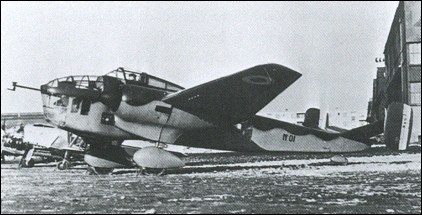| Andrë, e-mail, 17.10.2021 02:22 General characteristics
Crew: Three
Length: 11.35 m (33 ft 2 in)
Wingspan: 13.07 m
Height: 3.40 m
Wing area: 31.48 m2
Empty weight: 3,420 kg (6,078 lb)
Gross weight: 5,015 kg (8,201 lb)
Fuel capacity: 1250L
Powerplant: 2 × Gnome & Rhône 14M of 680 hp
Propellers: 3-bladed fixed pitch, wooden
Performance
Maximum speed: 415 km /h
Range: 600 km
Service ceiling: 8.500 m
Time to altitude: 6 min to 3,000 m (9,840 ft)
Wing loading: 118 kg /m2 (24 lb /sq ft)
Power /mass: 300 W /kg (0.182 hp /lb)
Armament
Guns: 3 machine guns, Nose, Rear and 1x offensive
Bombs: 10x 50kg (total of 500kg) reply |
| Anonymous, e-mail, 17.10.2021 02:18 Based on the SNCAC Nc.510 reconaissance plane, the reconaissance aircraft NC.510 of Societe Nationale de Construction Aeronautiques du Center (SNCAC) demonstrated disappointing flight performance on tests, which led to a strong design change, resulting in the designation NC.530.
The first flight of the new aircraft, which then carried the designation NC-530 Exp, took place in Bourges on June 29, 1939. The addition of Exp (Experience) pointed to the fact that the machine was considered an aerodynamic test bed for estimating the basic configuration rather than the prototype. In the interval between the seventh and eighth flights, the angle of the transverse V stabilizer was increased from 7 to 12, in addition, various stabilizer installations were tested. Ailerons were enlarged to the twenty-fifth flight, which took place on August 11. On August 25, 1939, the NC-530 Exp was delivered from Bourges to Toussus-le-Noble, and on September 5, the personnel of the Center d'Estais du Materiel Aerien launched official tests in Orléans -Brisi (Orleans-Bricy). October 17, six weeks later, NC-530 Exp was returned to Bourges for changes to engine hoods, oil coolers, stabilizer increases with the installation of horn compensation and rudder changes. Since the aircraft was still testing the flutter of the tail unit, the transverse V stabilizer was again increased, just as vertical plumage was increased. Changes in flaps and tail fins continued throughout the test program to achieve truly satisfactory handling characteristics.
Meanwhile, the prototype of the serial car NC-530 No.01 was being built in Bourges, and its flight test program began on December 29, 1939. If the console of the double-wing wing of the NC-530 Exp was covered with a cloth, then the NC-530 No.01 had a cladding of sheets of light alloy. The inclined V-pillars connecting the wing center wing with the middle part of the fuselage were removed, as it was determined that they bear part of the responsibility for the tail fluting of the NC-530 Exp in the early stages of testing. Like its predecessor, the cross-section of the fuselage NC-530 No.01 was close to rectangular, but the nose had an enlarged glazing area. The design of the fuselage was all-metal with sheathing of sheets of light alloy.
The observer was in the extreme forward of the fuselage; his workplace was equipped with a dual control, a short-wave SARAM 3.10 transceiver and a SAMM-AB54 mobile 7.5 mm machine gun for hid defense. Two more 7.5 mm machine guns were mounted on the plane: one of them, controlled by a pilot, was fixed and shot forward, the other was placed in the rear cabin on the Alkan 32H mobile unit.
The fuel system consisted of: two 345-liter tanks, located in the center wing wing, two 100-liter tanks, housed in the wing nacelle, two 180-liter tanks, located in the fuselage above the bomb bay.
The bomb bay itself could accommodate either an additional 650-liter fuel tank, or ten 50-kg bombs, or a hinged F300, F500 or F700 camera.
Soon it turned out that the design of NC-530 No.01 was also exposed to the flutter of the tail unit, which manifested itself in its predecessor NC-530 Exp at the earliest stage of testing. Also, there were shortcomings in the transverse control of the aircraft, which led to a series of changes in the tail unit.
The SNCAC proposed an alternative version of the basic design in which the Gnome-Rhone 14M 6 /7 engines were replaced by the 450-horse in-line inverted air cooling engines Renault 12R and in which the chassis cleaning mechanism was introduced. This model received the designation NC-531, but soon a more promising development √ NC-532 was due to appear. The basic design of the NC-530 was very strong, and it was expected that the machine could be installed engines with a power twice that of the original engines. Thus, the NC-532, whose wing span was increased from 13.00 m to 13.60 m, was designed to install two 1070-strong radial air-cooling engines Gnome-Rhone 14N 48 /49.
However, neither the NC-531 nor the NC-532 were built, and the NC-530 itself, despite its undoubtedly reliable design, had little chance of mass production, as Potez 63.11 was chosen as the main aircraft of the Groupes Aerial Survey Observation. Testing NC-530 No.01 continued in Bourges until May 1940, after which it was evacuated in June to Clermont-Ferrand-Aulnat, where it was destroyed. reply |





